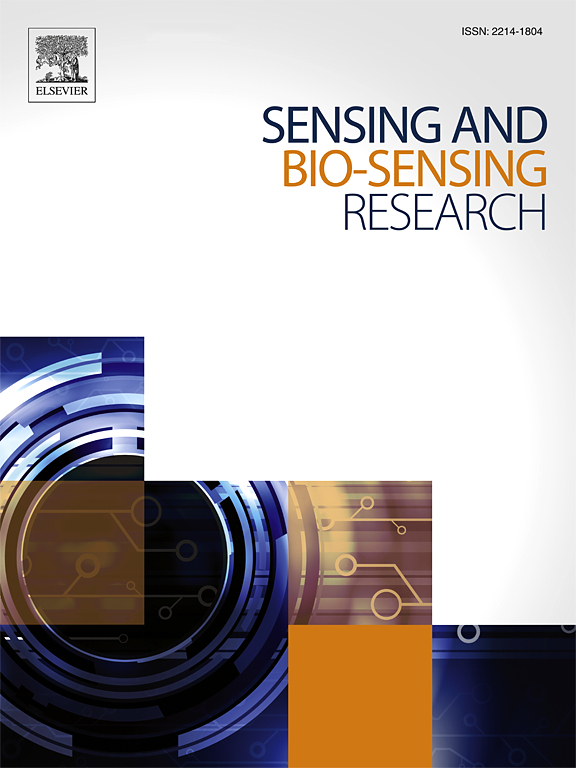Machine learning-enhanced graphene-gold hybrid metasurface sensor for high-precision terahertz detection of Isoquercitrin biomarkers
IF 4.9
Q1 CHEMISTRY, ANALYTICAL
引用次数: 0
Abstract
This study presents a sensor operating in the terahertz (THz) frequency range for the selective detection and quantification of isoquercitrin, a crucial flavonoid biomarker. Through optimization of graphene chemical potential (and geometric parameters, the sensor achieves exceptional sensitivity of 1000 GHz/RIU with a quality factor ranging from 7.849 to 8.000. The integration of machine learning algorithms, including an ensemble of Random Forest, Support Vector Machine, and Neural Network models, significantly enhances analytical capabilities with 98.7 % prediction accuracy and 2.3 μg/mL RMSE. The ML framework incorporates advanced spectral pre-processing with 95 % noise reduction, automated extraction of 127 spectral features, and real-time processing capabilities with sub-second response times (0.12 s). Electric field distribution analysis reveals optimal resonance at 0.68 THz with maximum field confinement, while the sensor demonstrates robust performance across varying incidence angles. The proposed system offers superior detection limits, high selectivity, and exceptional reliability with 95.3 % average prediction confidence, making it highly suitable for point-of-care diagnostics, nutraceutical quality control, and personalized health monitoring applications.
机器学习增强的石墨烯-金混合超表面传感器,用于高精度太赫兹检测异槲皮苷生物标志物
本研究提出了一种工作在太赫兹(THz)频率范围内的传感器,用于选择性检测和定量异槲皮苷,这是一种重要的类黄酮生物标志物。通过对石墨烯化学势和几何参数的优化,该传感器的灵敏度达到了1000 GHz/RIU,质量因子在7.849 ~ 8.000之间。机器学习算法的集成,包括随机森林、支持向量机和神经网络模型的集成,显著提高了分析能力,预测准确率为98.7%,RMSE为2.3 μg/mL。机器学习框架结合了先进的光谱预处理,降噪95%,自动提取127个光谱特征,以及亚秒级响应时间(0.12 s)的实时处理能力。电场分布分析表明,该传感器在0.68太赫兹时具有最大的场约束,同时在不同入射角下表现出稳健的性能。该系统具有优良的检出限、高选择性和卓越的可靠性,平均预测置信度为95.3%,非常适合于即时诊断、营养保健品质量控制和个性化健康监测应用。
本文章由计算机程序翻译,如有差异,请以英文原文为准。
求助全文
约1分钟内获得全文
求助全文
来源期刊

Sensing and Bio-Sensing Research
Engineering-Electrical and Electronic Engineering
CiteScore
10.70
自引率
3.80%
发文量
68
审稿时长
87 days
期刊介绍:
Sensing and Bio-Sensing Research is an open access journal dedicated to the research, design, development, and application of bio-sensing and sensing technologies. The editors will accept research papers, reviews, field trials, and validation studies that are of significant relevance. These submissions should describe new concepts, enhance understanding of the field, or offer insights into the practical application, manufacturing, and commercialization of bio-sensing and sensing technologies.
The journal covers a wide range of topics, including sensing principles and mechanisms, new materials development for transducers and recognition components, fabrication technology, and various types of sensors such as optical, electrochemical, mass-sensitive, gas, biosensors, and more. It also includes environmental, process control, and biomedical applications, signal processing, chemometrics, optoelectronic, mechanical, thermal, and magnetic sensors, as well as interface electronics. Additionally, it covers sensor systems and applications, µTAS (Micro Total Analysis Systems), development of solid-state devices for transducing physical signals, and analytical devices incorporating biological materials.
 求助内容:
求助内容: 应助结果提醒方式:
应助结果提醒方式:


